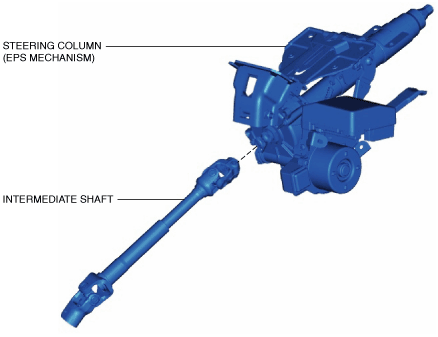STEERING COLUMN AND SHAFT
id061300245800
Purpose/Function
• The steering input force, generated when the driver operates the steering wheel, is transmitted to the steering gear.
Construction
• The steering column and shaft consists of the steering column with a built-in electric power steering (EPS) mechanism and the intermediate shaft.
• As a result of impact absorbing mechanisms on the steering column and intermediate shaft, when a collision occurs, the steering shaft effectively absorbs the impact energy that would be transmitted to the driver, thereby reducing injury.
• Due to the adoption of a tilt/telescope mechanism for the steering shaft on all vehicles, operability has been improved.
Operation
EPS mechanism
• Based on the steering torque signal from the torque sensor and the vehicle speed and engine speed signals from the PCM, the EPS control module (CM) drives the EPS motor and transmits the assist torque to the intermediate shaft via the deceleration mechanism.
Energy absorbing system
• At the moment of a collision, if impact energy is input from the vehicle front due to the rearward collapse of the steering gear (first stage impact), the intermediate shaft contracts. Impact energy cannot be absorbed by the contraction of the intermediate shaft, however, it will not be applied to the driver because the rearward collapse of the steering gear is smaller than the contraction of the intermediate shaft. (Section X in the figure)
• If the driver's body contacts the steering wheel (second stage impact), the fuse-shaped rivet in the capsule is sheared and the bracket and outer tube slide as a single unit along the slider and inner tube. At this timing, the U-shape plate deforms to absorb the impact to the driver. (Section Y in the figure)
Tilt/telescope mechanism
• The steering wheel can be moved in the up/down and forward/backward direction when the adjusting lever is pressed towards the front of the vehicle to release the lock of the tilt/telescope system.
• The tilt/telescope mechanism has a movement range of
45 mm {1.8 in} (tilt)/
50 mm {2.0 in} (telescope) and can be adjusted, without steps, to anywhere in this range.
Fail-safe
• Function not equipped.
